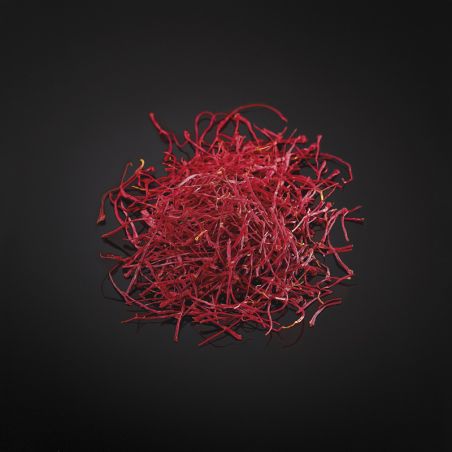


Saffron is used in cooking both for its aroma and for the golden-yellow colour it gives to dishes.
These characteristics make it a very popular condiment all over the world.
The Comptoir des Poivres gives you the ?saffron pearl" - "Neguine" in Persian and made only from the upper part of the crocus stigma.
It is an exceptional product !
Note : the packaging of this article is not suitable for gift boxes
Saffron is part of the spice family. It is used in cooking both for its aroma and for the golden yellow colour it gives to dishes.
This aroma and colour make it a highly prized condiment throughout the world, particularly in Iranian cuisine, wrongly labelled as "oriental cuisine".
Saffron can be used to accompany fish.
It can be found in paellas, bouillabaisse, tajines or risottos. Spanish, Moroccan and Italian cuisines are warmed up by this colourful spice.
It has been proven by numerous studies to be beneficial as a medicinal plant.
Its active agents - including safranal and crocin - are believed to have a strong antioxidant effect, but also to provide protection against cancer and have antimutagenic and immunoregulatory effects.
Saffron cultivation
Saffron is cultivated in several countries around the world, including France. But it was in Iran that the cultivation of this "red gold" began a few thousand years ago. Saffron cultivation is delicate and requires meticulous skills and knowledge.
The harvest is painstaking, concentrated over a particularly short period of time (the crocus only flowers for about twenty days a year).
The flower doesn't last long (48 hours maximum). The saffron flower, which can only be preserved for a maximum of 48 hours, has 6 purple petals, three golden-yellow stamens and a red pistil.
It is this pistil made up of three stigmas (filaments) which once dried gives the saffron used as a spice.
The crocus sativus pistils are collected one by one and then "peeled", separated and sorted with extreme skill.
This is work exclusively done by Iranian women, who remove the petals from the pistil, extract the stem and stamens and then carefully save the red upper part - the stigma.
It is this work worthy of that of a goldsmith that contributes to the cost of this exceptional product.
Neguine: the saffron pearl
Neguine means "Saffron Pearl" in Persian. It is an exceptional product, of the rarest and most renowned quality. The genuine Neguine saffron consists of the upper part of the crocus stigma only. A part with extraordinary aromatic power, with a characteristic deep red colour and which is harvested by hands as careful as a goldsmith?s.
The villages of Targh and Natanz are known as being the heart of saffron production in Iran.
The Comptoir des Poivres has been to meet the producers in these two villages to bring you only the best.
The genuine Neguine saffron consists of the upper part of the crocus stigma only.
Neither the white part nor the yellow part is added to this part with its extraordinary aromatic power, a characteristic deep red colour and harvested by hands as careful as a goldsmith?s.
At the Zabeti estate, the best flowers selected are those with exceptional quality, thick, long stigmas.
They are cut by women who were all former bakers or pastry chefs. In Iran, bakers are sensitive to the quality of the flour, which they judge by touch.
After years of judging the quality of the flour, their fingertips have become ultra-sensitive and can judge the softness and texture of the stigmas.
The latter are chosen one by one and only the red part is kept.
It takes 70 to 80 pistil ends to obtain 1g of Neguine saffron.
The stigmas are then dried on ceramic trays for about 72 hours in total darkness at room temperature. After drying and a loss of about 80% of its original weight, the saffron is refined in airtight glass jars so that this red gold is preserved at its best.
The rest of the stigmas are used to make a mixture of spices.
Every year, the Targh Cooperative organises a saffron colouring test. Each producer puts one gram of saffron into their own milk tank. The quality of each person's saffron is defined by the color and flavor of the liquid, which is then used to make "bastanie" ice cream. According to the test, one gram of saffron from the Zabeti estate can color and flavor 500 to 600 litres of milk.
Origin Targh, Irán
Weight 1 g net
Packaging box
Ingredients 100% saffran
Storage keep away from light, heat and moisture
Recommanded use Pastry Cooking Chocolate Ice cream
Botany Crocus sativus L. Filaments